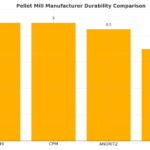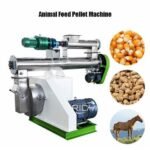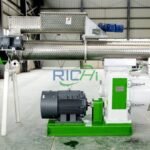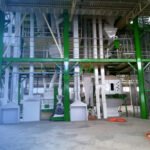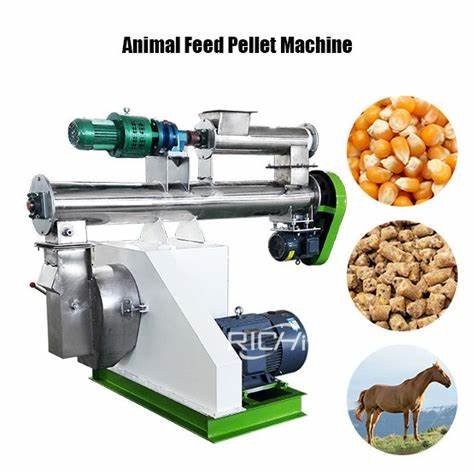1. Introduction
In recent years, the global agricultural industry has been increasingly focused on sustainable development, and the production and use of organic fertilizers have gained significant momentum. Organic fertilizer pellet machines play a crucial role in the production process of organic fertilizers by transforming various organic raw materials into granulated fertilizers. From an environmental perspective, the development of organic fertilizer pellet machines is closely related to reducing environmental pollution, conserving resources, and promoting ecological balance. This article will comprehensively analyze the development trends of organic fertilizer pellet machines from an environmental perspective.

2. Current Environmental Impact of Organic Fertilizer Pellet Machines
2.1 Energy Consumption
Most existing organic fertilizer pellet machines consume a certain amount of energy during operation. The main energy – consuming components include motors that drive the main working parts, such as rollers in compression pelletizers or screws in extrusion pelletizers, and heating systems (if any) for drying raw materials or facilitating the granulation process. High energy consumption not only increases production costs but also contributes to greenhouse gas emissions, especially if the energy source is mainly from fossil fuels. For example, a medium – sized compression pelletizer with a production capacity of 1 – 2 tons per hour may consume 15 – 30 kW of electrical energy for the main motor alone, and additional energy for heating can further increase the overall consumption.
2.2 Waste Generation
During the operation of organic fertilizer pellet machines, waste generation is also a concern. Some raw materials may not be fully granulated, resulting in the generation of unqualified products or waste materials. In addition, the wear and tear of components such as dies and rollers in the pellet machines may produce metal scraps, which need to be properly disposed of. If not managed well, these wastes can cause environmental pollution, especially if they contain harmful substances.
2.3 Emissions
Certain types of organic fertilizer pellet machines may produce emissions during operation. For example, when using heating systems to dry high – moisture raw materials, combustion – based heating sources may emit pollutants such as sulfur dioxide, nitrogen oxides, and particulate matter. In addition, the granulation process itself may generate dust emissions, which can have a negative impact on air quality and human health.
3. Development Trends of Organic Fertilizer Pellet Machines for Environmental Protection
3.1 Energy – Saving Technologies
High – Efficiency Motor Applications
One of the significant trends in the development of organic fertilizer pellet machines is the increasing use of high – efficiency motors. High – efficiency motors have a higher power factor and lower energy losses compared to traditional motors. By replacing the existing motors with high – efficiency ones, the energy consumption of the pellet machines can be significantly reduced. For example, some advanced high – efficiency motors can achieve energy savings of 10 – 20% compared to standard motors. This not only helps to reduce the carbon footprint of the organic fertilizer production process but also lowers the overall production cost.
Energy – Recovery Systems
Another important development trend is the adoption of energy – recovery systems in organic fertilizer pellet machines. For instance, in pellet machines with heating systems, waste heat recovery technologies can be applied. The hot exhaust gas from the drying process can be used to pre – heat the incoming raw materials or to heat the air in the production workshop. In addition, kinetic – energy recovery systems can be installed in some pellet machines. During the braking process of the main motor or conveyor belts, the kinetic energy can be converted into electrical energy and stored for later use. Although the amount of energy recovered may be relatively small, it can still contribute to overall energy conservation in the long run.
3.2 Waste – Reduction and Recycling
Optimization of Granulation Processes
To reduce waste generation, the granulation processes of organic fertilizer pellet machines are being continuously optimized. Through advanced control systems and precise parameter adjustments, the efficiency of the granulation process can be improved, ensuring that more raw materials are successfully granulated into qualified products. For example, using intelligent control systems to monitor and adjust the rotation speed, feed rate, and pressure in the pellet machine in real – time can minimize the production of unqualified products.
Recycling of Waste Materials
The recycling of waste materials generated by organic fertilizer pellet machines is also becoming more common. Metal scraps from worn – out components can be recycled and reused in the manufacturing of new components. Some unqualified organic fertilizer products can be re – processed through appropriate methods, such as re – mixing with fresh raw materials and re – granulating. This not only reduces waste disposal costs but also conserves resources.
3.3 Emission – Reduction Technologies
Dust – Collection and Filtration Systems
To address the issue of dust emissions, advanced dust – collection and filtration systems are being installed in organic fertilizer pellet machines. These systems can effectively capture the dust generated during the granulation process. For example, bag – type dust collectors use filter bags to trap dust particles, and electrostatic precipitators use electrostatic forces to separate dust from the air stream. By installing these dust – collection systems, the dust emissions from pellet machines can be significantly reduced, improving the air quality in the production area and the surrounding environment.
Clean – Energy – Powered Heating Systems
In response to the emissions from heating systems, there is a trend towards using clean – energy – powered heating systems in organic fertilizer pellet machines. For example, some pellet machines are now equipped with electric heating systems powered by renewable energy sources such as solar or wind power. In addition, biomass – fired heating systems are also being developed, which use renewable biomass fuels such as wood chips or agricultural residues. These clean – energy – powered heating systems can greatly reduce the emissions of pollutants such as sulfur dioxide, nitrogen oxides, and particulate matter.
3.4 Material – and Design – Related Environmental Improvements
Use of Environmentally – Friendly Materials
The materials used in the manufacturing of organic fertilizer pellet machines are also evolving towards more environmentally – friendly options. For example, in the construction of components such as rollers and dies, materials with better wear – resistance and longer service life are being selected, reducing the frequency of component replacement and thus minimizing waste generation. In addition, the use of biodegradable or recyclable materials in some non – critical parts of the pellet machines is being explored. For instance, certain plastic components can be made from biodegradable polymers, which can decompose naturally in the environment after their service life. (Related post: Organic Fertilizer Production Line)
Compact and Space – Saving Design
The design of organic fertilizer pellet machines is also moving towards a more compact and space – saving direction. A smaller footprint of the machine not only reduces the amount of land required for installation but also can potentially lead to energy savings in terms of lighting and heating in the production area. In addition, a more compact design can facilitate the integration of energy – saving and emission – reduction devices, such as waste – heat recovery systems and dust – collection units, into the machine.
4. Case Studies of Environment – Friendly Organic Fertilizer Pellet Machines
4.1 Case 1: A Small – Scale Organic Fertilizer Producer
A small – scale organic fertilizer producer replaced the traditional motor in its compression pellet machine with a high – efficiency motor. At the same time, the producer installed a simple waste – heat recovery system that used the hot air from the drying process to pre – heat the incoming raw materials. After these improvements, the energy consumption of the pellet machine decreased by about 15%, and the production cost was effectively reduced. In addition, by optimizing the granulation process through regular parameter adjustments, the amount of unqualified products was reduced by about 20%, minimizing waste generation.
4.2 Case 2: A Medium – Sized Organic Fertilizer Plant
A medium – sized organic fertilizer plant installed a bag – type dust – collection system and an electrostatic precipitator in its organic fertilizer pellet machine production line. The combined use of these two dust – collection devices reduced the dust emissions by over 90%, greatly improving the air quality in the production area. The plant also adopted a biomass – fired heating system for drying raw materials, which reduced the emissions of sulfur dioxide and nitrogen oxides by more than 80% compared to the previous fossil – fuel – fired heating system. As a result, the plant not only met the strict environmental protection requirements but also enhanced its social and environmental image.
5. Conclusion
In conclusion, from an environmental perspective, the development of organic fertilizer pellet machines is moving towards a more sustainable direction. The adoption of energy – saving technologies, waste – reduction and recycling measures, emission – reduction technologies, and the use of environmentally – friendly materials and improved designs are the main trends. These trends not only help to reduce the environmental impact of organic fertilizer production but also contribute to the long – term development of the organic fertilizer industry. Case studies have shown that these environmental – friendly improvements can bring both economic and environmental benefits. In the future, with the continuous progress of technology and the increasing emphasis on environmental protection, more advanced and environmentally – friendly organic fertilizer pellet machines are expected to emerge, further promoting the sustainable development of the agricultural industry.


